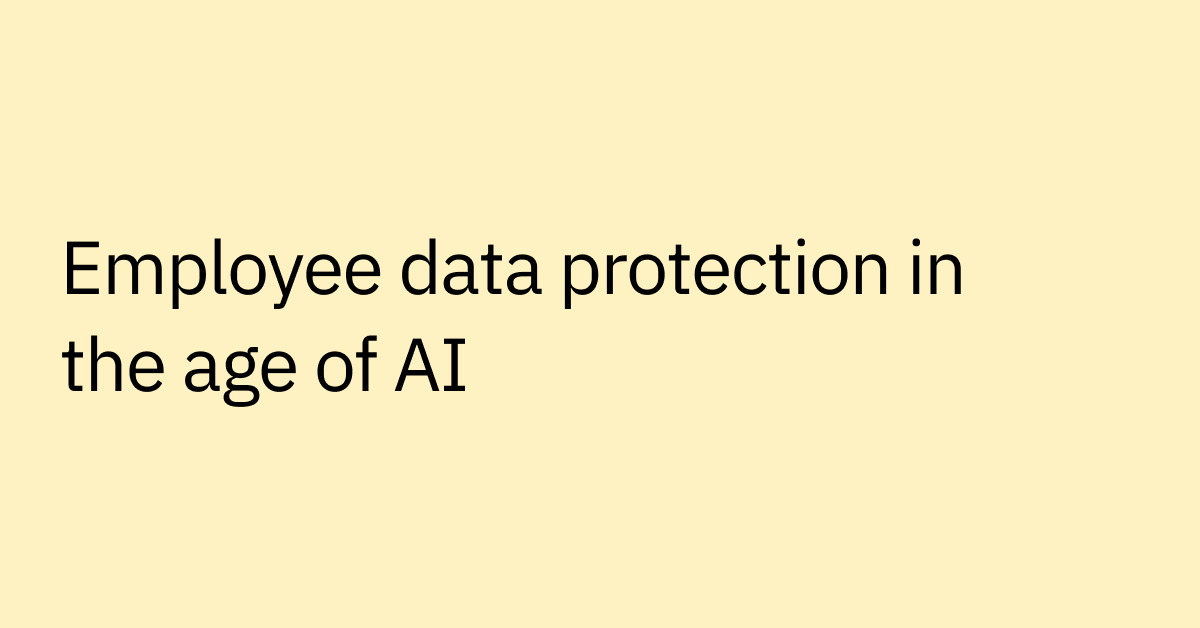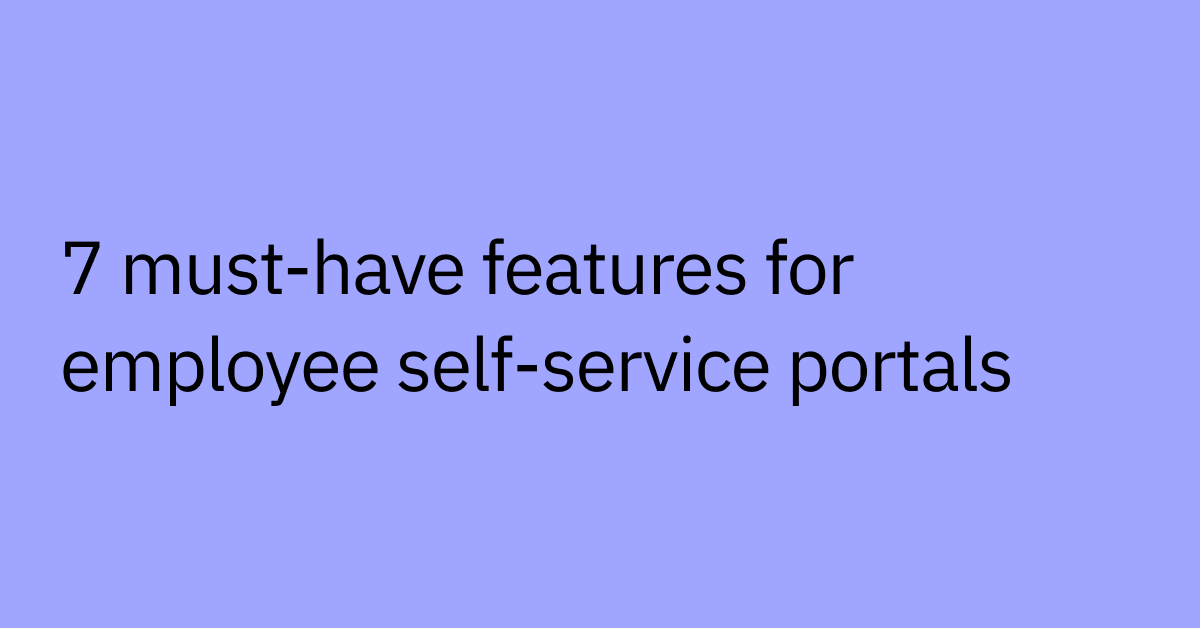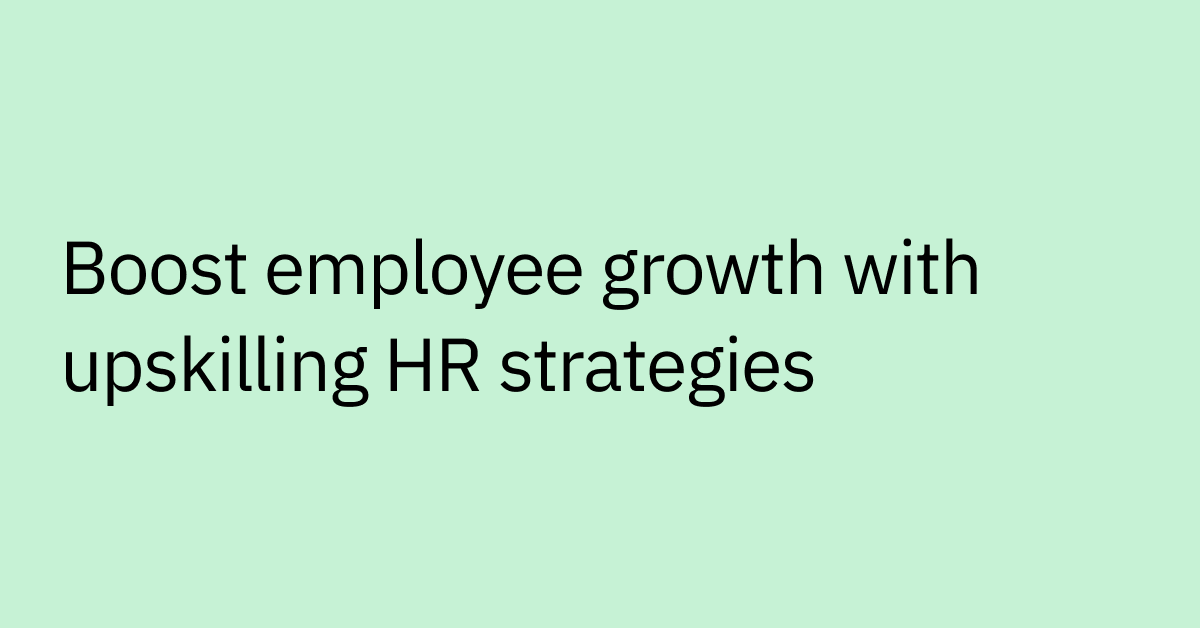Table of contents
Highlights
- Elevate the employee experience: Digital HR helps reduce friction, streamline onboarding, and support personalized learning and growth — boosting engagement and retention.
- Unify and modernize systems: Cloud HRIS platforms, intelligent automation, and agentic AI reduce silos and orchestrate workflows across tools.
- Deliver always-on support: Conversational and agentic AI provide scalable, multilingual support directly in Slack, Teams, and mobile apps — available 24/7/365.
- Strengthen compliance and security: Digital workflows enforce policies, reduce errors, and ensure every process is audit-ready.
- Empower HR teams: Automation and AI free HR from repetitive tasks, enabling focus on culture, talent, and strategic growth.
- Measure success continuously: Track employee experience, efficiency, and business impact to prove the value of transformation and guide ongoing improvements.
Employees today expect workplace support to feel as seamless as the apps they use in their personal lives: personalized, instant, and available on demand. But for many HR teams, the reality looks very different.
Instead of a single, connected experience, employees face a maze of portals and disconnected workflows, while HR staff is stuck:
- Digging through multiple systems to resolve a payroll issue.
- Answering the same benefits questions hundreds of times.
- Chasing down managers for overdue performance reviews.
IAt scale, these requests can snowball into a major drain on HR capacity — pulling teams away from culture, strategy, and growth.
The solution: Automation and AI.
Research shows that automating repetitive HR tasks with AI can save up to 20% of manual work — with HR operations teams seeing as much as 35% time savings. That shift frees HR to shift from firefighting to driving strategy.
As AI redefines workplace expectations, HR leaders like you face mounting pressure to close this gap quickly. Let’s take a look at how HR digital transformation helps you deliver real-time, personalized support across regions, roles, and devices. Employees get answers instantly, and HR leaders gain space to drive strategic outcomes for your business.
This is where HR digital transformation comes in: helping you deliver consumer-grade employee experiences, empower your HR team, and prove strategic value to the business.
What is enterprise HR digital transformation?
Enterprise HR digital transformation is the process of modernizing HR operations with digital technologies and artificial intelligence. The goal: streamline processes, make smarter decisions, and deliver better employee experiences.
Unlike automation, which is tactical and focused on single tasks like payroll updates or leave requests, transformation is strategic. It unifies systems, data, and workflows so HR can move from reactive service desk to proactive driver of agility, compliance, and growth.
AI is central to this shift. Beyond reducing repetitive work, it provides predictive insights, orchestrates workflows across tools, and personalizes employee support. With agentic AI, HR can go further—reasoning through requests, planning actions across multiple systems, and resolving issues instantly in tools like Slack, Teams, and email, all while respecting enterprise-grade security.
Digital transformation isn’t about patching together tools. It’s about creating a unified HR strategy that adapts to change, supports continuous improvement, and makes work simpler for everyone.
Why HR digital transformation is essential
Modern hybrid, global workforce has stretched traditional HR to the breaking point. Manual processes and fragmented systems can’t keep up with expectations for quick, personalized support. Deloitte reports managers now spend nearly 40% of their time on admin work—a massive productivity drain.
Organizations embracing AI-driven transformation see dramatic improvements, such as 35% less time spent on operational tasks. Beyond efficiency, agentic AI helps HR reason through complex requests, orchestrate workflows, and adapt instantly to policy changes. This means faster onboarding, proactive support, and real-time feedback channels that catch issues before they snowball.
But transformation only works when intentional. Without a clear plan, new tools can create more silos and wasted spend. Success requires aligning stakeholders, unifying systems, and designing every step around the employee experience.
Want to see how leading enterprises are making this shift? Watch our webinar on HR AI transformation for practical strategies and real-world results.
Want to see how leading enterprises are making this shift? Watch our webinar on HR AI transformation for practical strategies and real-world results.
Key pillars of HR digital transformation
Digital transformation in HR isn’t about stacking up tools. It’s about building a strong foundation that helps your people thrive while making your team more agile, efficient, and impactful. To get there, you’ll want to focus on a few key pillars:
Core HR modernization
Everything starts with your core systems. A modern cloud-based HRIS, like Workday, SAP SuccessFactors, or Oracle HCM, becomes your single source of truth for employee data. With this in place, you can simplify payroll, compliance, and workforce management so employees always get accurate, timely support no matter where they work.
Agentic AI and intelligent automation
Your team shouldn’t spend hours fielding repetitive requests. Automating leave approvals, payroll questions, and onboarding tasks removes friction, while agentic AI goes further — reasoning through complex requests, orchestrating actions across multiple systems, and delivering instant support in Slack, Teams, or email. The result: HR is free to focus on people and strategy, not paperwork.
Employee experience platforms
Employees expect to get help where they already work. Embedding HR support into Slack, Teams, or mobile apps makes finding answers or requesting services seamless. Combine that with personalized learning and career pathways, and you’re not just supporting employees — you’re helping them grow.
Data-driven decision-making
The right workforce analytics turn guesswork into foresight. From monitoring recruitment and DEI trends to predicting turnover risks or optimizing time-to-hire, data helps you act early, adjust faster, and build a healthier, more engaged workforce.
Culture and change management
Finally, none of this works without people embracing it. Equipping HR teams with new digital skills align leadership on goals, and roll out changes in phases to build trust and adoption. In the end, transformation is as much about people and mindset as it is about platforms and systems.
12 key benefits of HR digital transformation
When you modernize HR with AI and digital tools, the effects ripple across the organization: employees enjoy seamless experiences, HR gains time for strategic work, and the business becomes more agile. Here are the top 12 benefits and how you can achieve them.
Elevating the employee experience
1. Better employee retention and engagement
What it is: Digital HR platforms reduce everyday friction with self-service and AI-powered support, giving employees instant answers to questions about things like PTO balances or benefits updates. Agentic AI adds value by anticipating needs and managing issues across systems, helping to boost employee satisfaction.
When employees feel supported, engagement naturally increases. And engagement isn’t just a “feel-good” metric — it directly impacts retention and productivity too. Workers who feel heard and cared for are more likely to stay, reducing costly turnover.
Action: Audit your HR processes for bottlenecks like slow PTO or benefits requests and target them for automation. Pair these quick wins with personalized career development tools, so employees not only experience smooth day-to-day interactions but also see tangible opportunities for long-term growth.
2. Smoother onboarding processes
What it is: The first days define how employees perceive your company. Digital HR tools simplify onboarding by automating paperwork, benefits enrollment, and policy acknowledgments, cutting down on admin overload. AI assistants answer common questions instantly and ensure consistent onboarding across roles, teams, and regions — helping accelerate time-to-productivity and reduce early attrition.
Action: Review your onboarding journey for gaps or delays, then introduce automated workflows and AI-powered assistants that deliver policy, benefits, and training resources instantly.
3. Personalized learning and career growth
What it is: Employees expect timely, personalized growth opportunities. Modern HR platforms replace static annual reviews with continuous feedback, transparent goals, and real-time recognition. This clarity helps employees understand their progress and next steps.
Automation also frees managers from admin work, allowing them to focus on coaching and mentorship. With workforce analytics, you can identify performance trends, skill gaps, and engagement levels, ensuring development plans align with employee ambitions and business needs.
Action: Reevaluate your performance management process. Replace one-size-fits-all reviews with continuous feedback and clear career pathways, so employees understand how they can grow and succeed.
4. Scalable, 24/7 employee support
What it is: Employees expect support anytime, not just during HR office hours. Conversational AI provides always-on, multilingual support for payroll, benefits, and policies personalized to role, location, and even native language.
This scalability creates experiences that manual HR teams can’t match. Instead of waiting days for responses, employees get instant, accurate support. As AI learns over time, support grows smarter and adapts to evolving workforce needs. Hearst's AI Assistant, Herbie, resolves 57% of support issues autonomously, providing a unified source for employee support.
Action: Identify the most common HR support pain points in your organization. Deploy AI assistants to provide scalable, 24/7 help, freeing HR to focus on strategy while employees enjoy reliable, personalized support.
Empowering HR departments
5. Centralized HR processes and systems
What it is: Chances are, your HR team is juggling multiple systems: one for payroll, another for benefits, a different one for performance, plus a few spreadsheets in between. This creates data silos, duplicate work, and hours lost to switching between tools.
A unified digital platform changes that. By consolidating processes and connecting tools through AI agents and orchestration, you eliminate fragmentation and create a seamless flow of information.
Freedom Financial Network uses an AI assistant, Alfred, as a central point of contact, reducing the need to navigate multiple portals. With a single source of truth, employees get consistent answers, HR gains visibility, and leaders finally see the big picture without manual effort.
Action: Map out all your current HR systems and identify where data gets duplicated or lost in handoffs. Start by connecting your most-used tools through integration platforms or unified HR suites, then gradually phase out redundant systems to create one central hub for all employee data.
6. More time for higher-value HR work
What it is: Imagine your team no longer bogged down by routine leave requests and form updates. When repetitive work is automated and systems are connected, HR professionals reclaim the time and energy to focus on what truly matters: shaping culture, nurturing talent, and driving business transformation.
This elevates HR from a back-office function to a trusted partner, helping strengthen engagement and fuel organizational growth.
Action: Track how your HR team currently spends their time, then identify the top most time-consuming repetitive tasks, like leave approvals, benefits questions, or data entry. Automate these processes first for quick wins that immediately free up capacity for strategic initiatives like talent development and culture building.
7. Strengthened compliance and data security
What it is: Manual processes are error-prone, and in HR, even small mistakes can have costly consequences, both legal and financial. Digital workflows can help reduce that risk by enforcing consistent policies, capturing the correct documentation, and ensuring every step is audit-ready.
Beyond reducing compliance risk, this builds confidence among employees, who trust their data is protected, and stakeholders, who depend on accurate reporting. Regulators also gain assurance that your organization is meeting accountability standards.
Action: Conduct a compliance risk assessment of your current HR processes, focusing on areas like data handling, record retention, and policy enforcement. Implement automated workflows with built-in compliance checks and audit trails for your highest-risk areas first, such as background checks, training certifications, and sensitive data access.
Driving strategic value
8. Smarter workforce planning
What it is: Workforces never stand still. Employees develop new skills, roles evolve, and turnover patterns emerge. Without visibility, it’s hard to anticipate gaps or prepare for what’s ahead. Data-driven insights change that.
Predictive analytics can help you flag potential skill shortages, align staffing with business priorities, and highlight trends you might otherwise miss. With this sharper visibility, HR can plan for immediate needs while building the workforce required for long-term growth.
Action: Start collecting baseline workforce data on skills, performance, and retention patterns across departments and roles. Use this data to build predictive models that forecast turnover risks and skill gaps 6–12 months ahead, then create targeted retention and development programs for your most critical talent segments.
9. Strategic decision-making through data
What it is: Every HR interaction generates valuable information, but numbers on a dashboard aren’t enough. With advanced analytics, you can turn that data into actionable insights for leaders and stakeholders. Suddenly, you’re not just reporting on what happened — you’re guiding strategy by highlighting what’s likely to happen next.
From anticipating attrition risks to pinpointing engagement drivers, data insights position HR as a key contributor to business outcomes. Even more, these insights help you chart a clear transformation roadmap, ensuring your HR strategy adapts to evolving employee expectations and market shifts.
Action: Establish key HR metrics that directly tie to business outcomes, like employee engagement scores that correlate with customer satisfaction or retention rates that impact revenue growth. Create monthly executive dashboards that highlight predictive insights, not just historical data, positioning HR as a strategic advisor to leadership.
10. Global workforce enablement
What it is: As your enterprise expands across borders, delivering consistent and compliant HR support can quickly become a serious challenge. Employees expect quick, accurate answers no matter where they’re located or what language they speak.
With digital transformation, you can build multilingual support into your HR systems, so every employee, whether they’re in Durban, Singapore, or Washington D.C., gets the same high-quality experience.
At the same time, automated workflows can flex to meet local compliance rules while preserving global consistency. This balance ensures HR delivers both personalization and reliability at scale.
Action: Implement 24/7/365 multilingual AI support and configure workflows to reflect regional compliance needs. This ensures HR feels global yet seamless for employees everywhere.
Looking ahead: Emerging benefits of HR digital transformation
HR digital transformation doesn’t stop at improving today’s operations. As the workplace continues to evolve, it opens the door to new ways of supporting employees and keeping your organization agile in the face of change. Two emerging benefits show just how powerful this shift can be:
11. Employee well-being support
What it is: Digital HR platforms can surface early signs of burnout, track workload balance, and weave wellness resources into the flow of work. This matters more than ever, as 66% of American employees are experiencing burnout. Beyond the human cost, burnout drives higher healthcare spend, turnover, and lost productivity.
Action: Use engagement surveys, pulse checks, and analytics to keep a real-time pulse on your workforce. If AI notices warning signs, like a spike in late-night support requests, repeated searches for leave policies, or declining participation in check-ins, HR can intervene with targeted resources before disengagement or attrition takes hold.
12. Agility in organizational transformation
What it is: If the last few years have taught us anything, it’s that change can come fast, whether it's from a global pandemic (COVID-19), new regulations, or company acquisitions. Digital HR tools allow you to respond instantly, ensuring employees stay informed and supported through transitions.
For example, Palo Alto Networks uses generative AI to support its 15,000-person hybrid workforce — saving 351,000 productivity hours. This shows just how powerful automation can be in reducing friction and keeping employees focused during times of change.
Action: Build automated workflows that adapt instantly to major organizational shifts. This could mean updating compliance protocols across regions, sending targeted policy reminders, or reallocating resources in line with new priorities.
Summing it up
The benefits of HR digital transformation extend far beyond efficiency. From providing better employee experiences to enabling global scalability, the outcomes provide a framework for modernizing HR and proving strategic value.
Final action: Start with one high-friction HR process, like PTO requests, onboarding, or policy updates. Digitize it, measure the results, and expand systematically. Small, targeted wins build momentum, create trust across the business, and pave the way for lasting transformation.
Real-world examples of HR digital transformation
Across industries, enterprises are already using AI and automation to ease support burdens, speed up onboarding, and improve retention. Here are three examples that show what’s possible:
Example 1: Reducing HR support tickets with AI-powered self-service
As Databricks doubled in size, HR was buried in requests. To scale support, it launched R2DB, an AI assistant in Slack. At first, adoption was low and ticket deflection sat under 10%.
Instead of giving up, the team doubled down. They expanded R2DB to handle more workflows, educated employees directly in Slack, and fine-tuned its responses. Adoption skyrocketed—NPS hit 70 and ticket deflection reached 73%.
By integrating R2DB into Slack, email, ITSM, and HR platforms, Databricks unified support at scale.
The payoff: nearly $1.5M in annual savings and always-on support for 8,000 employees. Databricks turned hypergrowth into an opportunity, shifting HR from reactive firefighting to proactive, strategic employee enablement.
Example 2: Cutting onboarding time with automation
loanDepot, a leading mortgage lender, saw productivity stall as employees struggled with delayed responses and fragmented HR systems. Onboarding was challenging —new hires were left waiting for IT approvals or digging through portals, not only slowing productivity but also risked employee engagement during pivotal career moments.
To transform support, loanDepot launched ElleDee, an AI assistant built directly into Microsoft Teams. New hires could instantly message ElleDee for access, answers, and approvals that once took days—now resolved in under five minutes. This seamless onboarding gave employees confidence and allowed IT and HR to focus on higher-value work.
Example 3: Elevating support to improve employee engagement
Ciena’s global workforce struggled with siloed HR systems, causing delays and frustration. To fix this, the company launched Navi, an AI assistant in Microsoft Teams that unified HR, IT, and facilities workflows. Employees gained a single, 24/7 entry point for support—eliminating bottlenecks and long wait times.
The impact was immediate: faster approvals, quicker answers, and reclaimed HR capacity for strategic work. By transforming fragmented support into a seamless self-service model, Ciena delivered consistent, scalable, and employee-first HR support worldwide.
How to evaluate the success of HR digital transformation
Without clear metrics, even the most advanced tools risk becoming underused investments. Tracking the impact of your HR digital transformation not only proves ROI but also builds confidence with your stakeholders and helps you refine your strategy as workforce needs evolve.
A practical way to measure success is to focus on these three key areas:
- Employee experience metrics: Engagement scores, onboarding completion rates, and satisfaction with HR support tell you if employees actually feel the benefits. When they do, you’ll see stronger engagement, higher productivity, and deeper loyalty.
- Process efficiency metrics: Measure average response times, case deflection rates, and time-to-hire. These metrics reveal where digital solutions are reducing friction and where bottlenecks still exist.
- Business impact metrics: Track retention, compliance error reduction, cost savings, and productivity gains tie your HR outcomes directly to business goals. These are the numbers that win executive buy-in.
The good news? You don’t need to stitch this data together manually. Advanced AI platforms can surface these insights in real time, consolidating adoption rates, deflection trends, time-to-resolution improvements, and employee satisfaction scores too. Agentic AI goes further by continuously learning from outcomes — helping HR leaders not only measure results but also adapt strategies automatically.
Action: Set baseline measurements before you launch, then compare progress quarterly. Use those insights to double down on what’s working, fix what isn’t, and keep evolving. Remember: Transformation isn’t one-and-done, but an ongoing cycle of measurement, adaptation, and improvement.
Turn HR digital transformation into a strategic advantage
A strategic approach to HR digital transformation determines whether your organization simply digitizes processes or redefines the employee experience.
To reap the full benefits (greater employee engagement, efficiency, and resilience) you need solutions that unify systems, automate work, and deliver insights at scale.
That’s exactly what Moveworks agentic AI Assistant platform enables for your HR team can:
- Deliver consumer-grade employee experiences directly in Slack, Microsoft Teams, and other everyday tools with an always-on AI assistant, driving higher engagement and retention.
- Unify fragmented HR systems with robust integrations and agentic AI that reasons, plans, and takes action across multiple platforms.
- Automate routine HR processes like FAQs, case resolution, and approvals, freeing your teams to focus on strategy and culture.
- Strengthen compliance and security with role-based permissions and enterprise-grade protocols that protect sensitive data.
- Empower data-driven HR strategies using real-time analytics and employee experience insights.
Ready to transform? Get started with Moveworks today and discover how AI can help you turn HR digital transformation into a strategic advantage.
Frequently Asked Questions
Enterprises often struggle with integrating legacy systems, managing change across global teams, and ensuring compliance while moving to digital-first processes. You can overcome these hurdles by building a clear transformation roadmap, investing in change management, and choosing technologies that integrate seamlessly with your existing HR tech stack.
Start with clear business goals and involve stakeholders early in the process. Show exactly how digital transformation supports outcomes they care about most, like employee retention, engagement, and compliance. To gain lasting buy-in, communicate progress regularly and tie results back to metrics stakeholders care about most.
Change management is what ensures new systems don’t just get deployed but actually get used. Employees need to understand the benefits, feel supported, and have training that matches their role. Adoption strengthens when support is embedded directly in the tools people already use, like Slack or Microsoft Teams, and when leaders clearly connect the changes to improvements in the employee experience.
With better data and analytics, you gain a sharper view of hiring needs, skills gaps, and workforce trends. That means you can align HR strategy with evolving business priorities and adapt faster to market shifts. Over time, this proactive planning helps retain top talent and build a more agile workforce.
Think of transformation as an ongoing journey, not a one-time project. Regularly measure outcomes, collect employee feedback, and benchmark against KPIs like time-to-hire, resolution speed, or retention rates. Establishing feedback loops ensures you can refine processes as workforce needs evolve and sustain long-term value.
AI makes transformation effective by automating repetitive HR tasks, personalizing employee support, and providing predictive insights. For example, Moveworks AI Assistants deliver 24/7 multilingual support in Slack and Teams, while its analytics help HR leaders anticipate workforce needs and measure adoption in real time. This combination drives measurable value faster and at enterprise scale.
Start by assessing your current HR processes and pinpointing where employees face the most friction. Pick one high-impact area, like onboarding or case resolution, and digitize it first. That early win builds momentum, demonstrates value, and makes it easier to gain buy-in for broader transformation efforts.



